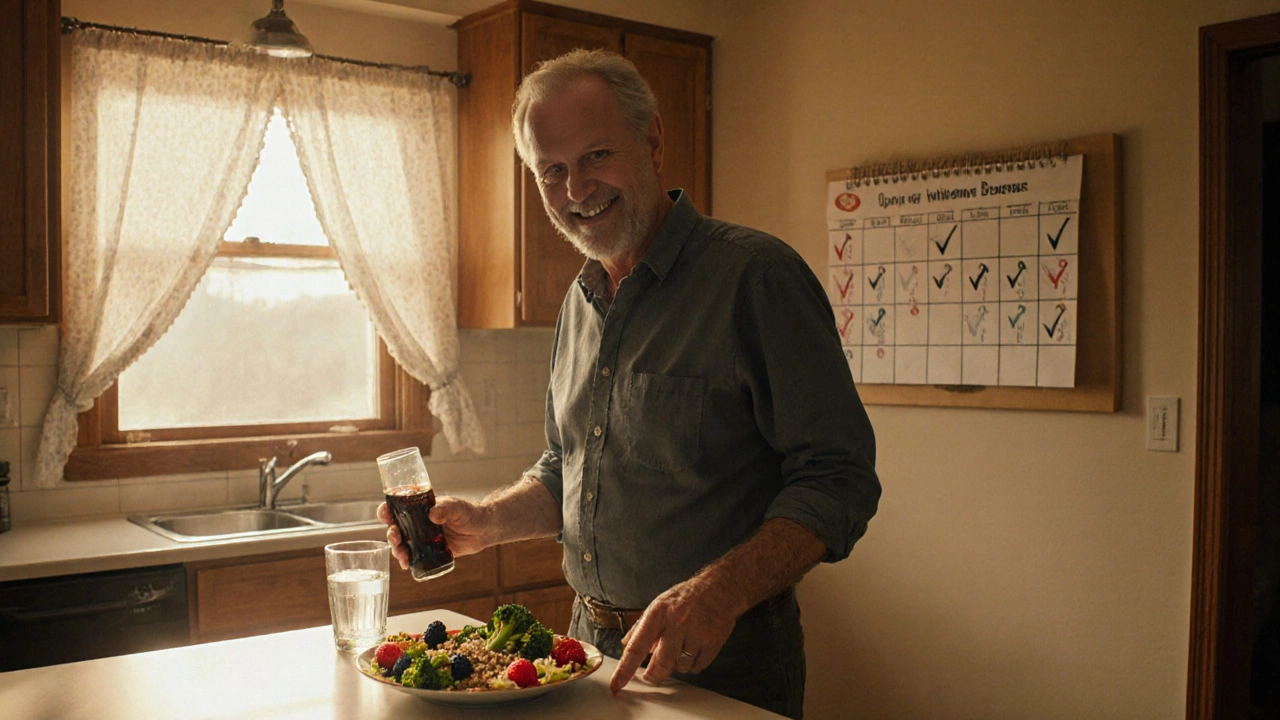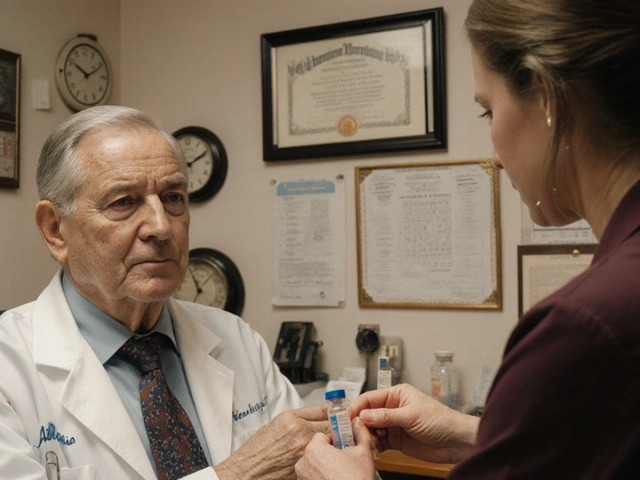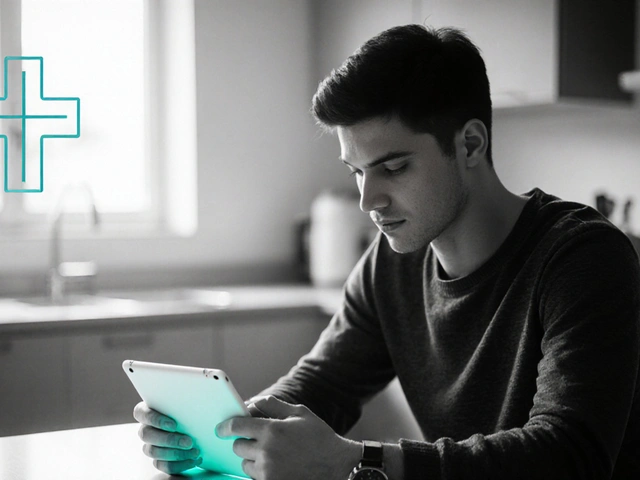What Prediabetes Really Means
You’re not diabetic. But your blood sugar is higher than it should be. That’s prediabetes - and it’s not a warning sign. It’s a doorway. One you can walk through to get healthier, or one that leads straight to type 2 diabetes.
More than 1 in 3 adults in the U.S. have it. Most don’t know. No symptoms. No pain. Just a lab result that says: something’s off.
The numbers don’t lie. If you do nothing, you have a 50% chance of developing type 2 diabetes within five years. That’s not a guess. That’s from the CDC. But here’s the part they don’t tell you: you can flip that script. Not with pills. Not with surgery. With your daily choices.
How Lifestyle Changes Actually Work
It’s not magic. It’s biology.
Your body uses insulin to move sugar from your blood into your cells for energy. When you eat too much sugar, too many refined carbs, and sit too much, your cells stop listening to insulin. That’s insulin resistance. Your pancreas works harder. Sugar builds up. That’s prediabetes.
Reversing it means teaching your cells to listen again. And the best way? Move more. Eat better. Lose a little weight - not a lot. Just enough to reset your system.
Studies show that losing 5% to 7% of your body weight cuts your diabetes risk by 58%. For someone who weighs 200 pounds, that’s 10 to 14 pounds. Not 50. Not 100. Just enough to make your body breathe again.
What to Eat - No Fads, Just Facts
You don’t need to go keto. Or vegan. Or juice cleanse.
You need to stop eating like your body’s still 20 years old.
- Swap white bread, white rice, and pasta for whole grains like quinoa, farro, and brown rice. They digest slower. Less sugar spike.
- Fill half your plate with non-starchy vegetables - broccoli, spinach, peppers, zucchini. Color matters. The more color, the more nutrients, the less room for junk.
- Ditch sugary drinks. Soda, sweet tea, fruit juice - they’re liquid sugar. Water, tea, or coffee (no sugar) are your new best friends.
- Reduce processed meats. Bacon, sausages, deli meats? They’re linked to higher diabetes risk. Choose fish, chicken, beans, or tofu instead.
- Add fiber. Beans, lentils, berries, chia seeds. Fiber slows sugar absorption and feeds your gut bacteria - which actually helps regulate blood sugar.
One study in Nature Medicine found people reversed prediabetes without losing weight at all. How? They changed what they ate. Less sugar. More fiber. More plants. That’s it.

Move - But Not Like You’re Training for a Marathon
You don’t need to run 5K. You just need to move every day.
The magic number? 150 minutes a week. That’s 30 minutes, five days a week. Or 20 minutes, seven days. Doesn’t matter how you split it.
Walk after dinner. Take the stairs. Park farther away. Dance while cooking. Gardening counts. Brisk walking - fast enough that you can talk but not sing - is perfect.
Strength training? Do it twice a week. Lift weights, use resistance bands, or do bodyweight squats and push-ups. Muscle burns sugar. More muscle = better blood sugar control.
One study showed that people who reversed prediabetes didn’t just lose fat - they lost belly fat. The kind that wraps around your organs. That’s the dangerous kind. Even if your scale didn’t change much, if your waist got smaller, you’re winning.
Why Weight Loss Isn’t Everything
Most people think: no weight loss = no results. That’s wrong.
Research from the University of Tübingen found that people who normalized their blood sugar without losing weight still cut their future diabetes risk by 70%. How? They reduced visceral fat - the fat around the liver and pancreas. That’s what messes with insulin.
That’s why the goal isn’t the scale. It’s your waistline. Your energy. Your blood test results.
Two people can weigh the same. One has a big belly. One doesn’t. The one with the belly? Higher risk. The one without? Even if they’re overweight, their body’s still responding to insulin. That’s the difference.
How to Make This Stick
Diets fail. Habits last.
Start small. Pick one thing. Maybe it’s swapping soda for sparkling water. Or walking 10 minutes after dinner. Do that for two weeks. Then add one more thing.
Don’t try to overhaul your life on Monday. That’s why most people quit by Wednesday.
Use the CDC’s National Diabetes Prevention Program. It’s free or low-cost if you have Medicare or private insurance. You get a coach. Weekly lessons. Real talk. No judgment. Just support. Over 1,600 programs are available online or in person.
Track your progress - not with a scale, but with how you feel. Better sleep? More energy? Fewer cravings? Those are the real wins.

What Doesn’t Work
Detox teas. Weight loss pills. Juice cleanses. Keto for life. Intermittent fasting without structure.
These might drop your weight fast. But they don’t fix insulin resistance. And when you go back to old habits? Sugar spikes again. Faster than before.
Medications like metformin can help - and doctors sometimes prescribe them. But lifestyle changes are still the gold standard. They work better. Longer. With no side effects.
And here’s the truth: if you’re waiting for a pill to fix this, you’re already behind. Your body’s asking for help. Give it the right tools.
It’s Not Too Late
Some people think prediabetes means they’ve already ruined their health. That’s not true.
The earlier you act, the better. But even if you’ve had prediabetes for years, your body still remembers how to heal. Cells regenerate. Insulin sensitivity improves. Blood sugar normalizes.
One woman in her 60s, diagnosed with prediabetes after her husband passed away, started walking every morning. She swapped chips for almonds. She cooked more. In eight months, her HbA1c dropped from 6.2% to 5.4%. Normal. No meds. Just consistency.
You don’t need to be perfect. You just need to be consistent.
What Comes Next
Get tested. If you’re over 35, overweight, or have a family history of diabetes - get your blood sugar checked. Fasting glucose, HbA1c, or an oral glucose tolerance test. It takes five minutes.
If you’re in the UK, ask your GP about the NHS Health Check. It includes diabetes risk screening.
If you’re diagnosed with prediabetes, don’t panic. Don’t delay. Start today. One meal. One walk. One change.
Because this isn’t about avoiding diabetes. It’s about reclaiming your life. More energy. Better sleep. Less worry. Longer life.
You don’t need to be a health expert. You just need to care enough to try.
Can prediabetes be reversed without losing weight?
Yes. A study in Nature Medicine showed people reversed prediabetes without losing weight by improving their diet - eating more fiber, fewer processed carbs, and more vegetables. The key was reducing visceral fat around the liver and pancreas, not total body weight. Blood sugar normalized, and diabetes risk dropped by 70% over 10 years.
How much weight do I need to lose to reverse prediabetes?
Losing 5% to 7% of your body weight is the target. For someone weighing 200 pounds, that’s 10 to 14 pounds. This level of weight loss, combined with 150 minutes of walking per week, reduces diabetes risk by 58%. But even smaller losses help - every pound counts.
Is walking enough exercise to reverse prediabetes?
Yes, if you do it consistently. Brisk walking - fast enough to raise your heart rate but still be able to talk - for 30 minutes, five days a week, meets the CDC’s recommendation. Adding two days of light strength training (like squats or resistance bands) boosts results. Movement matters more than intensity.
Can I reverse prediabetes with diet alone?
Diet is the most powerful tool. Cutting out sugary drinks, refined carbs, and processed foods, while eating more vegetables, whole grains, and legumes, can normalize blood sugar. But combining diet with movement gives the best results. Exercise helps your muscles use sugar without insulin, which reduces resistance faster.
How long does it take to reverse prediabetes?
Many people see improvements in blood sugar within 3 to 6 months. But lasting reversal takes longer. Studies show the biggest benefits come after 3 years of consistent habits. The goal isn’t a quick fix - it’s a lifetime of better health.
Are there free programs to help reverse prediabetes?
Yes. In the U.S., the CDC’s National Diabetes Prevention Program is often free or low-cost with insurance, including Medicare. In the UK, the NHS Health Check includes diabetes risk screening and referrals to local lifestyle programs. Many community centers, YMCAs, and online platforms offer structured support at little to no cost.







Liam Dunne
17 November 2025This is the kind of post I wish my doctor would write instead of handing me a pamphlet and saying 'eat less sugar.' I’ve been prediabetic for two years and just started walking after dinner. No magic, just consistency. My HbA1c dropped from 6.0 to 5.5 in 5 months. No meds. Just me, my sneakers, and a lot of tea.
Vera Wayne
18 November 2025I love this!! So many people think it's all about the scale, but it's really about how your body feels!! I swapped soda for sparkling water with lime, and my afternoon crashes? Gone!! I didn't even lose weight-but my energy? Like I'm 25 again!! You don't need to be perfect-you just need to start!!
Rodney Keats
18 November 2025Oh wow, another ‘just walk and eat broccoli’ miracle cure. Next they’ll tell me sunlight cures cancer. I’ve been ‘prediabetic’ for 7 years. I’ve tried everything. The only thing that worked? Metformin. And no, I don’t feel like a lab rat.
Patrick Merk
19 November 2025I’m Irish, so I’ll admit-I used to eat my weight in white bread and Guinness. But after my dad got diabetes, I swapped the bread for sourdough rye, started walking the dog twice a day, and honestly? I feel like a new person. No dramatic weight loss, but my waist shrunk by 3 inches. And yes, I still have a pint on weekends. Just not every night.
Laura-Jade Vaughan
21 November 2025OMG this is literally everything I’ve been screaming into the void for years 🙌✨ I stopped drinking OJ because I realized it’s basically sugar water with a fruit passport 🍊🚫 I now snack on almonds and dark chocolate (85%!) and my skin? Glow-up. My doctor was shocked. I didn’t lose weight, but I lost the fog. 💫
Jennifer Stephenson
21 November 2025Good information. Simple. Clear. Do the walking. Eat more greens. Avoid sugar drinks. That’s it.
Jess Redfearn
22 November 2025Wait, so you’re saying I don’t need to buy that $80 keto meal plan? I just need to stop eating donuts? That’s it? No supplements? No app? No tracking? I feel scammed.
Ashley B
23 November 2025This is all a lie. Big Pharma doesn’t want you to know that prediabetes is caused by fluoridated water and glyphosate in your bread. The CDC is a front for insulin manufacturers. They want you to think walking fixes it so you don’t sue them for poisoning you with high-fructose corn syrup since 1975. Wake up. Your blood sugar is a tool of control.
Scott Walker
25 November 2025I’m from Canada and I’ve been doing this for a year. Started with just swapping my morning bagel for oatmeal with chia. Now I cook most meals, walk with my kid after dinner, and honestly? I don’t even think about it anymore. It’s just… life. No drama. No guilt. Just better days.
Sharon Campbell
27 November 2025idk i tried walking but my knees hurt and i just ate a donut so whatever lol
sara styles
27 November 2025You think this is about diet and walking? Please. The real issue is the gut microbiome being destroyed by Roundup, EMFs from smart meters, and corporate GMO corn syrup flooding the food supply. The CDC study you cited? Funded by the American Diabetes Association, which gets millions from pharmaceutical companies. The only way to reverse prediabetes is a 30-day juice fast with organic kale, then a 12-hour fast every night while sleeping in a Faraday cage. I’ve done it. My HbA1c dropped from 6.4 to 5.1 in 21 days. No one else will tell you this because they’re too bought off.
Brendan Peterson
29 November 2025The 5-7% weight loss figure is misleading. It’s based on the Diabetes Prevention Program, which had a highly controlled cohort. Real-world adherence is under 30%. Also, muscle mass matters more than fat loss. If you’re metabolically obese but normal weight, you’re still at risk. The real key is insulin sensitivity-measured by HOMA-IR, not HbA1c alone.
Koltin Hammer
30 November 2025There’s something poetic about this, you know? We live in a world that sells us quick fixes-detox teas, fasting apps, AI meal planners-but the real healing? It’s quiet. It’s the walk you take after dinner when no one’s watching. It’s choosing the apple over the candy bar because you remember how your grandfather looked at the end. It’s not about control. It’s about reverence. For your body. For your future. For the fact that you’re still here, still able to choose. That’s the real reversal.
Willie Randle
1 December 2025Excellent summary. I’d add that sleep quality and stress management are equally critical. Cortisol spikes from chronic stress directly elevate blood glucose. Prioritize 7+ hours of sleep and incorporate mindfulness-even five minutes of deep breathing daily can reduce insulin resistance over time. Consistency, not intensity, is the cornerstone.
Connor Moizer
2 December 2025I was skeptical until I tried this. I lost 12 pounds, but honestly? The biggest win was not needing my afternoon nap anymore. I started with just cutting soda. Then added a 15-minute walk. Then swapped white rice for brown. Now I cook with my mom every Sunday. It’s not perfect. But it’s mine. And I’m not scared of my next blood test anymore.